I recently asked artist Joseph Nechvatal if I could interview him for my research paper. Below is a transcript of the interview:
KJ: Is there a reason that you use generative software as part of the piece as a message within your art work, or do you just use generative software as a process for making the work and it has no relevance to the actual art work? I was particularly thinking of your computer virus project ii as I would imagine using generative software played an important aspect within the meaning of this work, but I'm also curious about your other generative artworks too, cheers.
JN: Indeed I did not come to using generative software for its own sake or from an interest in the formal properties of generative software. After my first paintings were created using robot-assisted means in 1986, I sought to create paintings around the computer-assisted concept of the virus. So I developed this idea by considering an image as a host - used to host viruses: active agents whose role it is to manipulate and degrade the information contained in the image. The negative connotations of the HIV virus as a vector of disease is reflected in the principle of degradation of the image. But here, the virus is also the basis of a creative process, producing newness in reference to vector genetic information in biological systems.
KJ: I assumed this was the case with your computer virus ii project. Has there ever been a time when you employed generative art as just a process?
JN: No never.
KJ: Could you describe a little about your background and how you became interested in generative art?
JN: Sure. I took a BFA at Southern Illinois University in Carbondale first, making art in a permissive post-minimalist environment. I then went to Cornell University with the idea of getting an MFA, but found the art department there years behind Southern Illinois University, so I left and went to New York and Columbia University where I worked towards an MPhil, studying with Arthur Danto, most notably. In the late 90s I earned a Ph.D. in the philosophy of art and new technology at Roy Ascott's Centre for Advanced Inquiry in the Interactive Arts (CAiiA) at The University of Wales College. That was a fantastic intellectual experience. My research was focused on the immersive ideals behind virtual reality. You can examine the introduction and download the full thesis as a pdf file if you wish.
My involvement with Alife comes out of my artistic post-conceptual background. From 1991-1993 I worked as artist-in-resident at the Louis Pasteur Atelier and the Saline Royale / Ledoux Foundation's computer lab in Arbois, France on what I came to call The Computer Virus Project. This was my first experiment with computer viruses as a creative ploy. I created a series of digital paintings and a computer animation from this process. I worked there with Jean-Philippe Massonie at the Laboratoire MIS at the Université de Franche-Comté on the initial software - which was written in Basic. At the time I would launch a viral attack into the host image - which was my body of visual work accomplished up to that time. However there was nothing to see as the computer virus went through its procedures until I would check to see what had happened overnight.
The AIDS virus was impacting on me emotionally at the time, so it made sense to move in that direction. I wanted to overcome the fear I was feeling - and it expressed my attraction towards things beauté tragique. I think that the life/non-life idea inherent in the viral situation is fascinating. The text The Electronic Revolution by William S. Burroughs from 1970 was also key to the idea. In it he theorizes that the written word was literally a virus that made spoken word possible.
Then in 2002 I extended that artistic exploration into the field of viral artificial life through my collaboration with the programmer Stéphane Sikora. I met Stéphane at a conference organized by Prof. Jean-Claude Heudin called Virtual Worlds 2000, which was held at Pôle Universitaire Léonard de Vinci in Paris. The conference's goals, which, like the first Virtual Worlds conference in 1998, were to develop a discourse around the merging of Virtual Reality (VR) and Artificial Life (ALife) (what one might call VRALife). This involved the study of synthetic systems that exhibit behaviors characteristic of natural living systems inside virtual reality worlds.
I fell into conversation with Stéphane and from that we launched into a collaboration intended on extending my previous exploration with computer software modeled on the viral.
KJ: You were inspired by A-life work of John Conway. Is there anyone else's work that has particularly inspired you too?
JN: By the general cellular automata work of John von Neumann, by the genetic programming algorithms of John Koza and the auto-destructive art of Gustav Metzger.
KJ: Are there any art movements that have influenced your work?
JN: Dada, for sure. Also Conceptual Art.
KJ: Are there any reasons why you choose to simulate nature?
JN: It started when I was a sophomore at University, pursuing a degree in Sociology. I was deeply involved in the political/social issues of the early 1970s; i.e. the anti-war, woman’s liberation and equal rights movements. I was home in Chicago for the summer, working at some shit job to pay for my University expenses. Art had been a hobby-interest with me up to that point. Anyway, I was riding around downtown Chicago on a motorcycle, somewhat in a psychic funk. As I zoomed pass some cathedral, a large illuminated stain-glass window caught my eye. It was an intense moment of color in a black night. Something told me then and there that the way to social change was the way of nature in art - in that art addresses the natural inner unique individual rather than the group, the sociological statistical. In that sense I saw art as a means to foster social change from nature - bottom-up, rather than top down, if you will.
KJ: In an interview with Tom Barbalet for Biota.org you mentioned:
The Alife approach is only a painting tool or utilitarian expression in its manifestation. For me, my work with Alife is an abstract way of doing philosophically based art. Cyborg imagery in pop culture, I suppose, fruitfully fertilized this aesthetic effort by imaginatively inviting me to experience my ontology through losing track of my body and becoming what seems to be pure viral consciousness.
Do you mean a consciousness that exists without a body, a consciousness that has been invaded by another or did you have some other meaning in mind?
Could you explain what you mean by 'pure viral consciousness'?
JN: The history of art and the history of technology are often marked by ruptures. Most histories, overlook moments where deep fusion occurs, as I see happening now with viractuality. Perhaps, another temporal model for cultural consciousness is needed. Something other than the, majestic forward and upward thrusting model of evolution. Something more humbly folded in, on itself (as Deleuze suggests). Or perhaps something even more insinuatingly penetrating – as, in a viral-host model. I have chosen the viral model – so let us now consider the activities of the, viractual as a surge of emergent and embedded critical consciousness that ofers us a formal, clarity true to our age.
After a long period of temporal disjunctions following the demise of the modernist project and, the excessive abuses of the post-modernist non-project; I wish to now suggest that a new, clarifying paradigm has emerged based not, however, on the ideals of the raw, the pure or the, reduced - but rather on the internal tic-tic-tic bomb time of the embedded and patient viral, attack. So I am suggesting here a seething project of critique within critique that re-energizes, the broken gaps of temporal displacement that followed the demise of modernism and the, appearance of now listless – super fragmented – irresponsible – glut of post-modern deconstruction.
When looking at cultural production through the paradigm of the viral viractual, many former, binary oppositions fail to function in a stable way - and start to pulse – transfusing, consciousness. Most basically, even the defnitions of life and death are destroyed by this model;, as a biological virus is precisely neither alive nor not-alive – as it depends for its existence totally, on it's host's viability. The seeing-power of the host/parasite model alone must not escape us. A, virus cannot – and does not – exist alone. It exists solely by entering in and coupling. So when, we add the once binary defnitions of virtual and actual into the voluptuous viral model of, existence - and observe how they interact - a form of both/and fusion diference appears, dominant within the scope of the viractual lens.
KJ: I have read about the concept of viractual, which strives to create an interface between the biological and the virtual. I think most people would think of a keyboard or mouse as an interface, but would you also consider a program to be viractual?
JN: I think programing that leans towards the genetic programming can be. As you may know, genetic programming is a technique for writing code in a computer program based on artifcial intelligence that uses an algorithm-based method that takes its programming cues from biology. In my case from the biology of the virus. Indeed, for me, bio-tech genetic programming as applied to the traditions of painting and art music is so important to the ideas of viral viractuality that it may be said to be emblematic of it. This because it represents the seminal function of viractuality: that activity that occurs between the wild real-time and the captured archived.
KJ: Thanks so much, hope you have a good weekend.
JN: Same to Kay.
For more information on Joseph Nechvatal:
Website: http://www.nechvatal.net/
Blog: http://post.thing.net/blog/244
New book: Immersion Into Noise: http://www.openhumanitiespress.org/immersion-into-noise.html
leçOns de l'utopie 2011
Monday, 29 August 2011
Heart of Reeds
Heart of Reeds by Chris Dury, is a reed bed on Lewes Railway Land Nature Reserve: click here
Chris Drury makes connections between systems within the body to systems on the planet.
Below is a short video clip that I filmed at the site yesterday. I especially enjoyed watching the random dance of the flies :-) I added some effects to the video, but left the audio the same.
Chris Drury makes connections between systems within the body to systems on the planet.
Below is a short video clip that I filmed at the site yesterday. I especially enjoyed watching the random dance of the flies :-) I added some effects to the video, but left the audio the same.
Wednesday, 24 August 2011
Ron Arad's Curtain Call.
Last weekend I went to see Ron Arad's Curtain Call click here. Several artist's also created films specifically to be projected for this environment.
The installation consisted of lots of individual translucent filaments that were hung next to each other to create a huge circle. Films were projected onto the filaments, which could be viewed from both inside, and outside the circle. As visitors walked through the filaments to enter the circle, they temporarily became part of the projected image.
When I first entered, I sat more or less in the middle of the circle. To my left side of the circle was a projection of an audience, on the other side was a projection of a matador getting dressed for a bull fight. While I had read about some of the artists and projections beforehand, I knew straight away that this wasn't one of them. I'm totally opposed to animal cruelty, so initially I felt uneasy about this. After the matador finished getting dressed, he smoked a cigarette rather shakily. Suddenly loud sounds of the bull could be heard. I could feel the the creature's distressed emotions piecing through my body! Yet no image of a bull was shown. Upon realising that I was the bull in the bullring I felt very scared, and knew I was going to be killed.
I thought this was a really effective interactive way for people to empathise and put themselves in the position of the bull. This was by Ori Gersht.
One of films that I had read about previously expressed a dreamlike situation which was by SDNA. I particularly wanted to experience this. Instead of walking through a forest. I felt like a forest was walking through me. This was quite surreal and I really enjoyed this experience.
While there were many amazing projections, my favourites were the two that I have mentioned, one being very sad and the other a rather dreamlike and surreal experience.
The installation consisted of lots of individual translucent filaments that were hung next to each other to create a huge circle. Films were projected onto the filaments, which could be viewed from both inside, and outside the circle. As visitors walked through the filaments to enter the circle, they temporarily became part of the projected image.
When I first entered, I sat more or less in the middle of the circle. To my left side of the circle was a projection of an audience, on the other side was a projection of a matador getting dressed for a bull fight. While I had read about some of the artists and projections beforehand, I knew straight away that this wasn't one of them. I'm totally opposed to animal cruelty, so initially I felt uneasy about this. After the matador finished getting dressed, he smoked a cigarette rather shakily. Suddenly loud sounds of the bull could be heard. I could feel the the creature's distressed emotions piecing through my body! Yet no image of a bull was shown. Upon realising that I was the bull in the bullring I felt very scared, and knew I was going to be killed.
I thought this was a really effective interactive way for people to empathise and put themselves in the position of the bull. This was by Ori Gersht.
One of films that I had read about previously expressed a dreamlike situation which was by SDNA. I particularly wanted to experience this. Instead of walking through a forest. I felt like a forest was walking through me. This was quite surreal and I really enjoyed this experience.
While there were many amazing projections, my favourites were the two that I have mentioned, one being very sad and the other a rather dreamlike and surreal experience.
Tuesday, 23 August 2011
Clouds
I took these photos while on the train the other day. I found them interesting as some of the trees/bushes look very much like cloud formations :-)

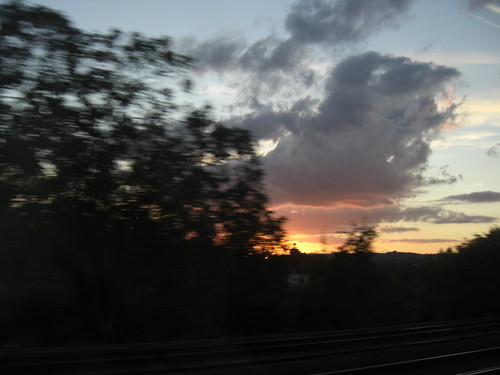
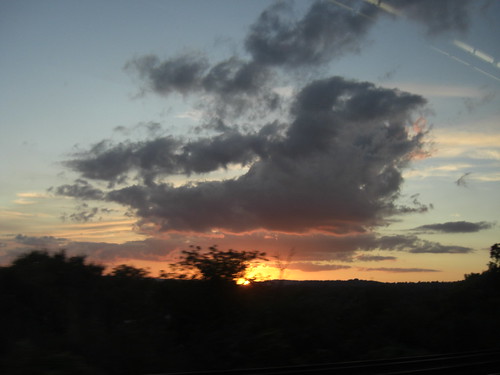
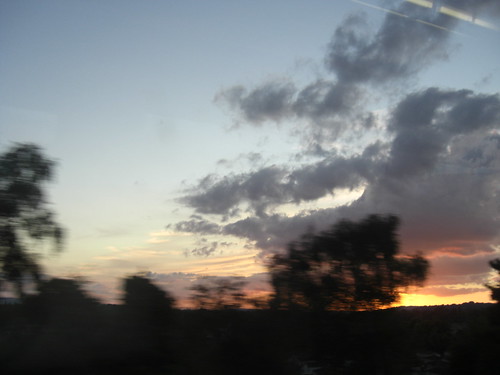
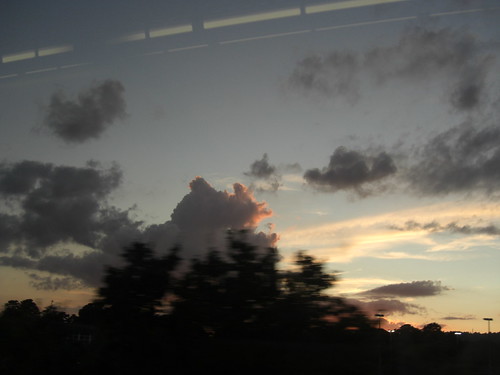





Labels:
Bushes,
clouds,
Generative Natural Elements,
Visual Research
Monday, 15 August 2011
Tutorial with Jonathan: Research Paper Question
This tutorial was quite short due to Kevin Fox coming to chat with us which I also found really helpful. He wrote a fab paper last year, click here for link.
Today's tutorial with Jonathan focused on my research paper question and a brief abstract. I usually write this at the end, but since we were all asked to write a brief abstract, I wrote one just for the time being. My question has been in a constant state of flux lately, but I now feel much happier with my latest question to explore:
Exploring Generative Art, by looking at how this process simulates nature and if this method is essential to the meaning of the artist's work? Looking at works through Joseph Nechvatal, Philip Galanter, Shardcore and Sam Hewitt.
Abstract:
The term Generative art is mainly know or thought of as a process. It is not an art movement or ideology, yet it does appear to be a process that artist's use to simulate aspects of life, whether this be for metaphysical/ontological inquiry, or simply though observing and copying characteristics of nature by employing generative systems to create aesthetic patterns.
Feedback from Jonathan:
I think your latest title that you sent me is excellent, much more focused
and manageable. As you have just been talking about with Kevin, avoid presumptions and you are doing this now, obviously your abstract will expand a bit when you have finished the paper, but overall it is looking good and I'm excited to see the outcome! I suggest you keep the interviews short and focused, the same questions for each and record obviously. Check with each that they are happy to have the transcript included in the paper, as they have agreed to be interviewed it should be ok, but they might want to see the transcript before the submission. Although you have primary sources, remember that we are looking for at least ten citations, so you will need some other sources as well, obviously your primary interviews will be the main things, but you may find connections with other writers or theorists. Other than that, I am happy! Great well done.
Today's tutorial with Jonathan focused on my research paper question and a brief abstract. I usually write this at the end, but since we were all asked to write a brief abstract, I wrote one just for the time being. My question has been in a constant state of flux lately, but I now feel much happier with my latest question to explore:
Exploring Generative Art, by looking at how this process simulates nature and if this method is essential to the meaning of the artist's work? Looking at works through Joseph Nechvatal, Philip Galanter, Shardcore and Sam Hewitt.
Abstract:
The term Generative art is mainly know or thought of as a process. It is not an art movement or ideology, yet it does appear to be a process that artist's use to simulate aspects of life, whether this be for metaphysical/ontological inquiry, or simply though observing and copying characteristics of nature by employing generative systems to create aesthetic patterns.
Feedback from Jonathan:
I think your latest title that you sent me is excellent, much more focused
and manageable. As you have just been talking about with Kevin, avoid presumptions and you are doing this now, obviously your abstract will expand a bit when you have finished the paper, but overall it is looking good and I'm excited to see the outcome! I suggest you keep the interviews short and focused, the same questions for each and record obviously. Check with each that they are happy to have the transcript included in the paper, as they have agreed to be interviewed it should be ok, but they might want to see the transcript before the submission. Although you have primary sources, remember that we are looking for at least ten citations, so you will need some other sources as well, obviously your primary interviews will be the main things, but you may find connections with other writers or theorists. Other than that, I am happy! Great well done.
Thursday, 11 August 2011
Cloud Formations
To be honest I haven't felt like doing any artwork due to the riots here in the UK at the moment. Also the anger and arguments on my Facebook news feed has got so bad too. Some people seem so irrational and have even been threatening one another! Yesterday I decided that I needed to escape from all this anger and get back into my project. I went out with my camcorder and filmed clouds and bubbles :-)
Below is a short video clip of low level clouds that were moving quite fast, while the higher level clouds were moving very slow and were almost static in comparison. I used the original audio sound and stretched it and slightly speeded up the film. I then colourised the video, plus adding some effects. This now looks nothing like the calm clouds that I was viewing but I am quite pleased with the outcome :-)
Below is a short video clip of low level clouds that were moving quite fast, while the higher level clouds were moving very slow and were almost static in comparison. I used the original audio sound and stretched it and slightly speeded up the film. I then colourised the video, plus adding some effects. This now looks nothing like the calm clouds that I was viewing but I am quite pleased with the outcome :-)
Tuesday, 2 August 2011
Generative Natural Elements: Dragon Clouds
Yesterday I saw some amazing cloud formations that reminded me of flying dragons. Below are some of the photos that I took of them :-)
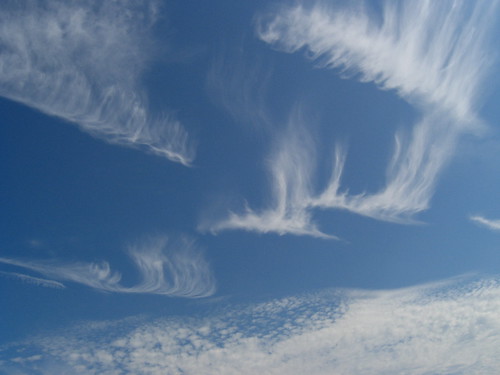

















Subscribe to:
Posts (Atom)

